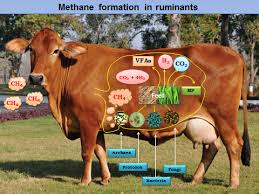Rumen Manipulation to Improve Animal Productivity
Fermentative activity is of greater importance in the digestive process of ruminants because the feed which is taken by the animal has to undergone fermentation before enzymatic digestion in abomasums and intestine. To avail maximum fermentation and to reduce the loss of energy during this process, we need to manipulate the ruminal fermentation.Manipulating Rumen fermentation through treatment of Roughage, concentrate and strategic supplementation with organic acids could improve rumen efficiency by maintaining higher pH, opt ammonia-nitrogen, thus reducing methane and increasing microbial protein synthesis and essential VFAs, for enhancing ruminant productivity in the tropics. Decreased methane production in favor of propionate to improve the energy balance of animals. Van Nevel and Demeyer (1988) identified five possible sites for improvements in ruminant fermentation. a) Increasing the digestibility of structural CHO (cellulose, Hemi cellulose, Pectin, Starch) and control lactic acid concentration. b)Protecting dietary protein against microbial degradation in the rumen and increase bioavailability of amino acids in the small intestine. c)Altering microbial end-products of fermentation. d)Improving the net microbial growth and fiber digestion. e)Reducing the rate of Ammonia release from NPN.
Manipulation of rumen fermentation is a key aspect of optimizing the digestive processes in ruminant animals, such as cattle, sheep, and goats. The rumen, a large fermentation chamber, houses a complex microbial community that breaks down fibrous plant materials into nutrients. Efficient rumen fermentation is essential for the overall health, productivity, and nutrient utilization in ruminants. Here’s an exploration of the various strategies employed to manipulate rumen fermentation:
WAYS TO ALTER FERMENTATION
Altering the composition of diet and feeding method are the traditional ways of altering rumen fermentation. Recently, various chemical compounds were shown to alter rumen fermentation parameters. Defaunation or removal of protozoa is well known to affect rumen fermentation. Scientist all around the world proposed the introduction of genetically modified strains of rumen bacteria for manipulating the rumen fermentation in various ways especially fiber degradation. But still it is in preliminary stage.
Removal of non ciliated protozoa from the rumen
Non ciliated protozoa’s are non-essential for the survival and growth of ruminants. In vitro culture of protozoa till date hasn’t produced any noticeable success. So, animals are used widely to evaluate the role of protozoa in nutrition and productivity of ruminant. Four ways to obtain cilia-free animals.
1. Chemical agents: Chemical defaunation agents are lethal to animal health. Toxic level varies from one animal to another animal within the species. Ionophores are used commonly but its use is restricted due to development of antimicrobial resistance. So no chemical agents presently in use for either experimental use or commercial use. E.g. Sodium Sulfosuccinate, Copper Sulfate and Monensin.
2. Dam-young separation after 48hr of Parturition: This technique is applicable nowadays because here the animals are isolated at birth and reared separately which prevents the contact and inoculation from mother. This technique requires a big animal stock reared with special care from birth to mature age.
3. Diet and feeding regime: This is the ideal. In vitro addition of Tannin containing plants depress the population. Similarly additions of Colloidal hydrated aluminium silicate (Clay)-2g/day, depress 69% protozoa population by interfering with ciliary motion. Antimicrobial agents (Salinomycin, Lasalocid, and Monensin) decrease protozoa population. a) Manipulation of Carbohydrate (CHO) fermentation Ad libitum feeding of concentrates (e.g. barely) results complete disappearance of ciliates. Increasing fiber or starch fermentation will result in increased VFA production in the rumen results in high ruminal lactate concentration i.e. low pH, leads to Ruminal Acidosis. Increase Concentrate feeding also results in low pH of the rumen because of highly digestible capacity than forages. Low pH favors the growth of Streptococcus bovis and Lactobacillus spp which favors lactate (10 times stronger than VFAs) production and its accumulation. Lactate Accumulation can be prevented by 1) inhibiting lactic acid production, 2) enhancing lactic acid fermentation to propionate. Increased production of propionate is beneficial to the animal because it decrease the methane production in the rumen. Supplementation of Organic Acids like Malate, Fumarate and Aspartate with CHO resources is more beneficial to ruminants, because organic acids stimulate specific ruminal micro population rather inhibit by Ionophore compounds. e.g., Selenomonas ruminantium (Strictly anaerobic) is the one spp where use reductive or reverse citric acid cycle known as succinatepropionate pathway to synthesize succinate and propionate. b) Manipulation of Nitrogen metabolism Nitrogen utilization is affected by many factors such as dietary N conc., Degradability, microbial community, and their interaction with other nutrients). Manipulating N metabolism in the rumen is to enhance ruminal escape of dietary protein by minimizing its degradation and optimizing microbial protein production from NPN. Minimization of protein degradation can be achieved by intervening at the proteolysis, peptidolysis or a.a deamination stages. This will reduce losses incurred in the conversion of dietary protein to microbial cell protein. Ammonia is a prime intermediate in the conversion of dietary N to microbial N. Besides N microbial protein synthesis in the rumen requires other nutrients, such as sulfur and vitamins. The goal in manipulating microbial protein synthesis is to increase efficient production by improving NH3 assimilation and urea recycling, thereby minimizing N excretion. Urea recycling provides a great advantage when ruminants are fed low-protein diets. c) Manipulation of Lipid Fermentation Compounds such as fatty acids shown some defaunating properties which may be probably due to fatty acids rather than oil itself. Improving of the Fatty acids profile of ruminant can be achieved by two distinct approaches. i. Modification of the Fatty acids profile during meat or milk processing such as drying, heating etc., ii. Modification through the changes in animal diet ultimately leads to greater bypass of dietary Fatty acids from the rumen, or might be a consequence of altered microbial metabolic activity. Commonly used fat supplements such as oilseeds are more inert i.e. rumen protected fats. Oil rich in Unsat FA are relatively more digestible in the small intestine than sat fats, but when fed oilseeds at high conc. can interfere with ruminal fermentation and metabolic processes such as milk fat synthesis in the mammary gland. The extrusion process of oilseeds likely results in a faster and greater availability of oil in the rumen than when whole oil seeds are fed.
4. Physical treatment: such as emptying the rumen shown to be effective and reliable. It’s a routine procedure in physiological experiments and doesn’t appear to harm the animal also, but addition of HCHO increases the danger of digestive disorders. In general, defaunation decrease the conc. of VFA in rumen, this is due to absence of protozoal stimulation on bacterial metabolism. Addition of probiotics in the diet: Fungal feed additives or Fungal Probiotics (Yeast or filamentous fungi-Saccharomyces cerevisiae and Aspergillus oryzae) can be given to animals at any stage unlike ionophores which can be given in less quantity that too in specific period.
Dietary Manipulation:
Forage-to-Concentrate Ratio:
- Importance: Altering the ratio of forage to concentrate in the diet influences rumen fermentation.
- Effect: High-forage diets promote fiber digestion, while high-concentrate diets enhance starch fermentation.
Particle Size:
- Importance: The size of feed particles affects rumen fermentation.
- Effect: Smaller particle sizes increase surface area, aiding microbial activity and nutrient absorption.
Fiber Quality:
- Importance: High-quality forage with optimal fiber content is crucial.
- Effect: Quality fiber supports microbial growth, maintains rumen pH, and prevents acidosis.
Probiotics and Prebiotics:
Probiotics:
- Introduction: Beneficial microorganisms (e.g., bacteria, yeast) added to the diet.
- Effect: Enhances microbial diversity, improves fiber digestion, and stabilizes rumen pH.
Prebiotics:
- Introduction: Non-digestible compounds that promote the growth of beneficial microbes.
- Effect: Supports the proliferation of desirable microorganisms in the rumen.
Ionophores:
Introduction:
- Use: Feed additives like monensin and lasalocid.
- Effect: Alters rumen fermentation by favoring propionate production, reducing methane emissions, and enhancing feed efficiency.
Feed Additives:
Enzymes:
- Introduction: Commercial enzymes to enhance fiber degradation.
- Effect: Improves the breakdown of complex plant materials, increasing nutrient availability.
Buffers:
- Introduction: Compounds like sodium bicarbonate.
- Effect: Helps maintain optimal rumen pH, preventing acidosis in high-concentrate diets.
Fermentation Modifiers:
Tannins:
- Introduction: Plant-derived compounds in some forages.
- Effect: Modulates rumen fermentation, reduces methane production, and enhances nitrogen utilization.
Essential Oils:
- Introduction: Extracts from plants like oregano or thyme.
- Effect: Affects microbial populations, reduces methane emissions, and may have antimicrobial properties.
Precision Feeding:
Real-time Monitoring:
- Use of Technology: Sensors and monitoring devices.
- Effect: Allows real-time assessment of rumen conditions, enabling adjustments to the diet.
Strategic Feeding Programs:
Adaptive Feeding:
- Importance: Adjusting diets based on physiological stages.
- Effect: Optimizes nutrient availability during different production phases.
Nutritional Supplements:
Vitamins and Minerals:
- Importance: Ensuring proper nutrition.
- Effect: Supports overall health and enhances rumen function.
Conclusion:
Manipulating rumen fermentation is a multifaceted approach involving diet, additives, and management strategies. These techniques aim to optimize the conditions for beneficial microorganisms, support nutrient utilization, and maintain the overall health and productivity of ruminant animals. As research continues to advance, precision feeding and targeted interventions offer promising avenues for further enhancing rumen fermentation efficiency in a sustainable and economically viable manner.
Rumen Manipulation to Improve Animal Productivity
Rumen Manipulation to Improve Animal Productivity
Compiled & Shared by- This paper is a compilation of groupwork provided by the
Team, LITD (Livestock Institute of Training & Development)
Image-Courtesy-Google
Reference-On Request




